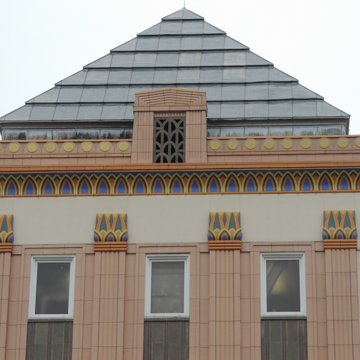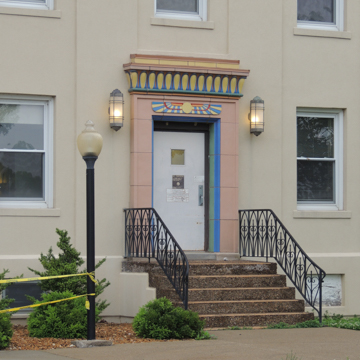The Marion Veterans Hospital illustrates the federal government’s commitment to the care of veterans following World War I as well as the care taken to integrate these facilities into their surrounding communities. Yet it is also a good example of how large-scale plans can erode over time.
The federal government built two veteran’s hospitals in suburban Chicago in the 1920s: Maywood in 1921 and North Chicago in 1926. Soon after, lobbying began for the construction of a similar facility in the far southern part of the state. After ten years of intense lobbying by local veterans groups and politicians, the site for a southern Illinois veterans’ facility was finally approved in April 1939. This was the culmination of an evolutionary process that consolidated medical care for the hundreds of thousands of World War I veterans under one federal agency. Of particular concern was the poor or non-existent care for veterans with mental health problems or tuberculosis. The Marion facility was part of a building program intended to care for these patients in suburban or rural environments that were regarded as healthier than urban institutions. There was an enormous surge in construction of veterans’ facilities in the late 1930s: by 1939, forty-five projects were under way, most of them funded through the Public Works Administration.
The plans for the Marion Veterans Center followed the Veterans Bureau formula and included a small medical and surgical facility, a large home for aging veterans (with three additional buildings planned), and a main hospital for veterans needing long-term care. Support buildings included dorms for nurses, power plants, laundries, and kitchens. The initial plans were for a campus of eleven main buildings set on 130 wooded acres to the west of Marion, a major transportation hub for the region. Nine more buildings were planned for future expansion. All of the rural veterans’ facilities used stock drawings, an “architectural set,” but the Veterans Bureau wanted the buildings to fit with the predominant local architectural style. While most veterans’ hospitals were completed in the Georgian Revival style, Marion’s well-executed and colorful Egyptian Revival reflected the nickname “Little Egypt” given to southern Illinois.
The campus is approached via a long, tree-lined main drive that leads to the imposing main building. A grand staircase leads to the main entrance located in the pyramid-topped central pavilion. Constructed of cream-colored stucco over brick, the building is Moderne in feel with its broad H-shaped plan and vertical bands of windows set in streamlined walls under flat roofs. The decoration, by contrast, is entirely and exuberantly Egyptian Revival. Done primarily in a soft clay color with brilliant blue, yellow, and orange accents, the decoration is a jubilant celebration of its style. Swelling papyrus capitals adorn the four massive pilasters on the entrance pavilion and colorful zig-zags ornament the entrance canopy. A deeply coved cornice decorated with colorful Egyptian motifs is used on the entrance pavilion to signify the break between the two main floors and the “attic” floor. It supports two powerful gold federal eagles. A small sarcophagus with papyrus grillework centers on the stepped pyramid of the pavilion’s roof.
The colorful coved cornice runs around the entire building, including the upper floor of the entrance pavilion. On the main wings of the building, a flat, horizontal band of stucco topped by a narrow, clay-colored, terra-cotta molding defines the break between the two lower floors and the attic floor. Throughout the building, vertically ribbed terra-cotta panels between the windows are a darker gray-brown, providing an additional accent.
The attention to detail in the Egyptian Revival decoration is exceptional. Even the flagpole in the traffic circle in front of the main entrance is vaguely Egyptian, as are the exterior light fixtures. Although the main entrance to the hospital is now closed due to the lack of wheelchair accessibility, the original entrance lobby is still maintained on what is now the building’s second floor. It is a tour de force of color, with bright yellow and blue pilasters with terra-cotta, blue, and white bases and capitals. Deep burgundy marble wainscot is topped by clay-colored walls and the ceiling’s coved cornice is highlighted by a wide mint green band. Despite its vibrant color scheme the hospital is a model of modern hygiene, with its clean painted surfaces and terrazzo floors.
Wartime labor and materials shortages forced the Marion Veterans Hospital to greatly reduce its initial plans. Five buildings were eliminated as early as 1941. Although the expansive, wooded grounds on the western edge of Marion are still intact, only the main building, a nurse’s dorm, and some service buildings were completed. The nurse’s dorm is a great indicator of what the rest of the planned buildings might have looked like, with the same careful attention to the Egyptian Revival theme.
The hospital has completed several additions in recent years, including two large elevator stacks flanking the main entrance. None of these bland additions take away from the vigor of the original Egyptian Revival decorative scheme.
References
Ryan, Robert A., “Marion, Illinois Veterans Administration Building,” Williamson County, Illinois. Historic American Buildings Survey (HABS IL-1155-A), 1989. National Park Service, U.S. Department of the Interior, Washington, D.C.
















